Biodegradable and Petroleum-Based Microplastics Do Not Differ in Their Ingestion and Excretion but in Their Biological Effects in a Freshwater Invertebrate Gammarus fossarum
Abstract
1. Introduction
1.1. Microplastic Particles as an Environmental Issue
1.2. Effects of Petroleum-Based and Biodegradable Microplastic Particles
1.3. Research Gap
1.4. Study Aim, Study System and Study Organism
1.5. Experimental Approach and Hypotheses
1.6. Natural Particles as a Realistic Double Control
2. Materials and Methods
2.1. Study Organisms
2.2. Microplastic Particles Preparation
2.3. Food Preparation
2.4. Preparations Prior to Experiments
2.5. Experimental Design
2.5.1. Particle Size- and Concentration-Dependent Ingestion and Excretion Experiment
2.5.2. Effect Experiment
2.6. Statistical Analyses
3. Results
3.1. Ingestion and Excretion Experiment
3.2. Effect Experiment
3.2.1. Feeding Rate
3.2.2. Assimilation Efficiency
3.2.3. Wet Weight Change
4. Discussion
4.1. Ingestion
4.2. Excretion
4.3. Differences in Ingestion and Egestion between Microplastic Particles and Environmental Relevance of Concentrations
4.4. Feeding Rate
4.5. Assimilation Efficiency
4.6. Wet Weight Change
4.7. Effects of Biobased and Biodegradable Plastics on Organisms
4.8. Challenges to the Digestive System of Benthic Consumers—The Importance of Microbiota
5. Conclusions
Acknowledgments
Author Contributions
Conflicts of Interest
References
- Barnes, D.K.A.; Galgani, F.; Thompson, R.C.; Barlaz, M. Accumulation and fragmentation of plastic debris in global environments. Philos. Trans. R. Soc. Lond. B Biol. Sci. 2009, 364, 1985–1998. [Google Scholar] [CrossRef] [PubMed]
- Woodall, L.C.; Sanchez-Vidal, A.; Canals, M.; Paterson, G.L.J.; Coppock, R.; Sleight, V.; Calafat, A.; Rogers, A.D.; Narayanaswamy, B.E.; Thompson, R.C. The deep sea is a major sink for microplastic debris. R. Soc. Open Sci. 2014, 1, 140317. [Google Scholar] [CrossRef] [PubMed]
- Obbard, R.W.; Sadri, S.; Wong, Y.Q.; Khitun, A.A.; Baker, I.; Thompson, R.C. Global warming releases microplastic legacy frozen in Arctic Sea ice. Earths Future 2014, 2, 315–320. [Google Scholar] [CrossRef]
- Van Cauwenberghe, L.; Devriese, L.; Galgani, F.; Robbens, J.; Janssen, C.R. Microplastics in sediments: A review of techniques, occurrence and effects. Mar. Environ. Res. 2015, 111, 5–17. [Google Scholar] [CrossRef] [PubMed]
- Mani, T.; Hauk, A.; Walter, U.; Burkhardt-Holm, P. Microplastics profile along the rhine river. Sci. Rep. 2015, 5, 17988. [Google Scholar] [CrossRef] [PubMed]
- Ivar Do Sul, J.A.; Costa, M.F. The present and future of microplastic pollution in the marine environment. Environ. Pollut. 2014, 185, 352–364. [Google Scholar] [CrossRef] [PubMed]
- Wright, S.L.; Thompson, R.C.; Galloway, T.S. The physical impacts of microplastics on marine organisms: A review. Environ. Pollut. 2013, 178, 483–492. [Google Scholar] [CrossRef] [PubMed]
- Cole, M.; Webb, H.; Lindeque, P.K.; Fileman, E.S.; Halsband, C.; Galloway, T.S. Isolation of microplastics in biota-rich seawater samples and marine organisms. Sci. Rep. 2014, 4, 4528. [Google Scholar] [CrossRef] [PubMed]
- Watts, A.J.R.; Urbina, M.A.; Corr, S.; Lewis, C.; Galloway, T.S. Ingestion of plastic microfibers by the crab Carcinus maenas and its effect on food consumption and energy balance. Environ. Sci. Technol. 2015, 49, 14597–14604. [Google Scholar] [CrossRef] [PubMed]
- Wright, S.L.; Rowe, D.; Thompson, R.C.; Galloway, T.S. Microplastic ingestion decreases energy reserves in marine worms. Curr. Biol. 2013, 23, R1031–R1033. [Google Scholar] [CrossRef] [PubMed]
- Lee, K.W.; Shim, W.J.; Kwon, O.Y.; Kang, J.H. Size-dependent effects of micro polystyrene particles in the marine copepod Tigriopus japonicus. Environ. Sci. Technol. 2013, 47, 11278–11283. [Google Scholar] [CrossRef] [PubMed]
- Ogonowski, M.; Schür, C.; Jarsén, Å.; Gorokhova, E. The effects of natural and anthropogenic microparticles on individual fitness in Daphnia magna. PLoS ONE 2016, 11, e0155063. [Google Scholar] [CrossRef] [PubMed]
- Green, D.S.; Boots, B.; Sigwart, J.; Jiang, S.; Rocha, C. Effects of conventional and biodegradable microplastics on a marine ecosystem engineer (Arenicola marina) and sediment nutrient cycling. Environ. Pollut. 2015, 208, 426–434. [Google Scholar] [CrossRef] [PubMed]
- Green, D.S. Effects of microplastics on european flat oysters, Ostrea edulis and their associated benthic communities. Environ. Pollut. 2016, 216, 95–103. [Google Scholar] [CrossRef] [PubMed]
- García Molinos, J.; Viana, M.; Brennan, M.; Donohue, I. Importance of long-term cycles for predicting water level dynamics in natural lakes. PLoS ONE 2015, 10, e0119253. [Google Scholar] [CrossRef] [PubMed]
- Peoples, O.P.; Sinskey, A.J. Polyhydroxybutyrate (PHB): A model system for biopolymer engineering. In Novel Biodegradable Microbial Polymers; Dawes, E.A., Ed.; Springer: Dordrecht, The Netherlands; Boston, MA, USA; London, UK, 1990; pp. 191–202. ISBN 978-94-009-2129-0. [Google Scholar]
- Reddy, C.S.K.; Ghai, R.; Kalia, V.C. Polyhydroxyalkanoates: An overview. Bioresour. Technol. 2003, 87, 137–146. [Google Scholar] [CrossRef]
- Becker, L.C.; Bergfeld, W.F.; Belsito, D.V.; Hill, R.A.; Klaassen, C.D.; Liebler, D.C.; Marks, J.G., Jr.; Shank, R.C.; Slaga, T.J.; Snyder, P.W.; et al. Final report of the Cosmetic Ingredient Review Expert Panel safety assessment of polymethyl methacrylate (PMMA), methyl methacrylate crosspolymer, and methyl methacrylate/glycol dimethancrylate crosspolymer. Int. J. Toxicol. 2011, 30, 55–65. [Google Scholar] [CrossRef] [PubMed]
- Duis, K.; Coors, A. Microplastics in the aquatic and terrestrial environment: Sources (with a specific focus on personal care products), fate and effects. Environ. Sci. Eur. 2016, 28, 1–25. [Google Scholar] [CrossRef] [PubMed]
- Gerhardt, A.; Bloor, M.; Mills, C.L. Gammarus: Important taxon in freshwater and marine changing environments. Int. J. Zool. 2011, 2011, 2–4. [Google Scholar] [CrossRef]
- Mehennaoui, K.; Georgantzopoulou, A.; Felten, V.; Andreï, J.; Garaud, M.; Cambier, S.; Serchi, T.; Pain-Devin, S.; Guérold, F.; Audinot, J.-N.; et al. Gammarus fossarum (Crustacea, Amphipoda) as a model organism to study the effects of silver nanoparticles. Sci. Total Environ. 2016, 566–567, 1649–1659. [Google Scholar] [CrossRef] [PubMed]
- Blarer, P.; Burkhardt-Holm, P. Microplastics affect assimilation efficiency in the freshwater amphipod Gammarus fossarum. Environ. Sci. Pollut. Res. 2016, 23, 23522–23532. [Google Scholar] [CrossRef] [PubMed]
- Drobne, D.; Blazic, M.; Van Gestel, C.A.M.; Leser, V.; Zidar, P.; Jemec, A.; Trebse, P. Toxicity of imidacloprid to the terrestrial isopod Porcellio scaber (Isopoda, Crustacea). Chemosphere 2008, 71, 1326–1334. [Google Scholar] [CrossRef] [PubMed]
- Gergs, R.; Rothhaupt, K.O. Feeding rates, assimilation efficiencies and growth of two amphipod species on biodeposited material from zebra mussels. Freshw. Biol. 2008, 53, 2494–2503. [Google Scholar] [CrossRef]
- Au, S.Y.; Bruce, T.F.; Bridges, W.C.; Klaine, S.J. Responses of Hyalella azteca to acute and chronic microplastic exposures. Environ. Toxicol. Chem. 2015, 34, 2564–2572. [Google Scholar] [CrossRef] [PubMed]
- McGrath, C.C.; Matthews, R.A. Cellulase activity in the freshwater amphipod Gammarus lacustris. J. N. Am. Benthol. Soc. 2000, 19, 298–307. [Google Scholar] [CrossRef]
- Charron, L.; Geffard, O.; Chaumot, A.; Coulaud, R.; Jaffal, A.; Gaillet, V.; Dedourge-Geffard, O.; Geffard, A. Influence of molting and starvation on digestive enzyme activities and energy storage in Gammarus fossarum. PLoS ONE 2014, 9, e96393. [Google Scholar] [CrossRef] [PubMed]
- Bundschuh, M.; Zubrod, J.P.; Schulz, R. The functional and physiological status of Gammarus fossarum (Crustacea; Amphipoda) exposed to secondary treated wastewater. Environ. Pollut. 2011, 159, 244–249. [Google Scholar] [CrossRef] [PubMed]
- Gutow, L.; Eckerlebe, A.; Gimenez, L.; Saborowski, R. Experimental evaluation of seaweeds as vector for microplastics into marine food webs. Environ. Sci. Technol. 2015, 50, 915–923. [Google Scholar] [CrossRef] [PubMed]
- Kampfraath, A.A.; Hunting, E.R.; Mulder, C.; Breure, A.M.; Gessner, M.O.; Kraak, M.H.S. Decotab: A multipurpose standard substrate to assess effects of litter quality on microbial decomposition and invertebrate consumption. Freshw. Sci. 2012, 31, 1156–1162. [Google Scholar] [CrossRef]
- Hämer, J.; Gutow, L.; Köhler, A.; Saborowski, R. Fate of microplastics in the marine isopod Idotea emarginata. Environ. Sci. Technol. 2014, 48, 13451–13458. [Google Scholar] [CrossRef] [PubMed]
- Bender, R.; Grouven, U.; Ziegler, A. Varianzanalyse für Messwertwiederholungen. Dtsch. Med. Wochenschr. 2007, 132, e61–e64. [Google Scholar] [CrossRef] [PubMed][Green Version]
- Cole, M.; Lindeque, P.; Fileman, E.; Halsband, C.; Goodhead, R.; Moger, J.; Galloway, T.S. Microplastic ingestion by zooplankton. Environ. Sci. Technol. 2013, 47, 6646–6655. [Google Scholar] [CrossRef] [PubMed]
- Maltby, L.; Clayton, S.A.; Wood, R.M.; McLoughlin, N. Evaluation of the Gammarus pulex in situ feeding assay as a biomonitor of water quality: Robustness, responsiveness, and relevance. Environ. Toxicol. Chem. 2002, 21, 361–368. [Google Scholar] [CrossRef] [PubMed]
- Fielding, N.J.; Macneil, C.; Dick, J.T.A.; Elwood, R.W.; Riddell, G.E.; Dunn, A.M. Effects of the acanthocephalan parasite Echinorhynchus truttae on the feeding ecology of Gammarus pulex (Crustacea: Amphipoda). J. Zool. 2003, 261, 321–325. [Google Scholar] [CrossRef]
- Field, A. Repeated Measures Anova. Discovering Statistics. Available online: https://www.discoveringstatistics.com/ (accessed on 7 December 2017).
- Coleman, C.O. Foregut morphology of Amphipoda (Crustacea). An example of its relevance for systematics. Ophelia 1992, 36, 135–150. [Google Scholar] [CrossRef]
- Bärlocher, F.; Kendrick, B. Leaf-conditioning by microorganisms. Oecologia 1975, 20, 359–362. [Google Scholar] [CrossRef] [PubMed]
- Castaneda, R.A.; Avlijas, S.; Simard, M.A.; Ricciardi, A. Microplastic pollution in St. Lawrence river sediments. Can. J. Fish. Aquat. Sci. 2014, 71, 1767–1771. [Google Scholar] [CrossRef]
- Dedourge-Geffard, O.; Palais, F.; Biagianti-Risbourg, S.; Geffard, O.; Geffard, A. Effects of metals on feeding rate and digestive enzymes in Gammarus fossarum: An in situ experiment. Chemosphere 2009, 77, 1569–1576. [Google Scholar] [CrossRef] [PubMed]
- Green, D.S.; Boots, B.; Blockley, D.J.; Rocha, C.; Thompson, R. Impacts of discarded plastic bags on marine assemblages and ecosystem functioning. Environ. Sci. Technol. 2015, 49, 5380–5389. [Google Scholar] [CrossRef] [PubMed]
- Bärlocher, F. The contribution of fungal enzymes to the digestion of leaves by Gammarus fossarum koch (amphipoda). Oecologia 1982, 52, 1–4. [Google Scholar] [CrossRef] [PubMed]
- Welden, N.A.C.; Cowie, P.R. Long-term microplastic retention causes reduced body condition in the langoustine, Nephrops norvegicus. Environ. Pollut. 2016, 218, 895–900. [Google Scholar] [CrossRef] [PubMed]
- Müller, C.; Townsend, K.; Matschullat, J. Experimental degradation of polymer shopping bags (standard and degradable plastic, and biodegradable) in the gastrointestinal fluids of sea turtles. Sci. Total Environ. 2012, 416, 464–467. [Google Scholar] [CrossRef] [PubMed]
- Yang, Y.; Yang, J.; Wu, W.-M.; Zhao, J.; Song, Y.; Gao, L.; Yang, R.; Jiang, L. Biodegradation and mineralization of polystyrene by plastic-eating mealworms: Part 2. Role of gut microorganisms. Environ. Sci. Technol. 2015, 49, 12087–12093. [Google Scholar] [CrossRef] [PubMed]
- Romani, A.M.; Sabater, S. Structure and activity of rock and sand biofilms in a Mediterranean stream. Ecology 2001, 82, 3232–3245. [Google Scholar] [CrossRef]
- Battin, T.J.; Kaplan, L.A.; Denis Newbold, J.; Hansen, C.M.E. Contributions of microbial biofilms to ecosystem processes in stream mesocosms. Nature 2003, 426, 439–442. [Google Scholar] [CrossRef] [PubMed]
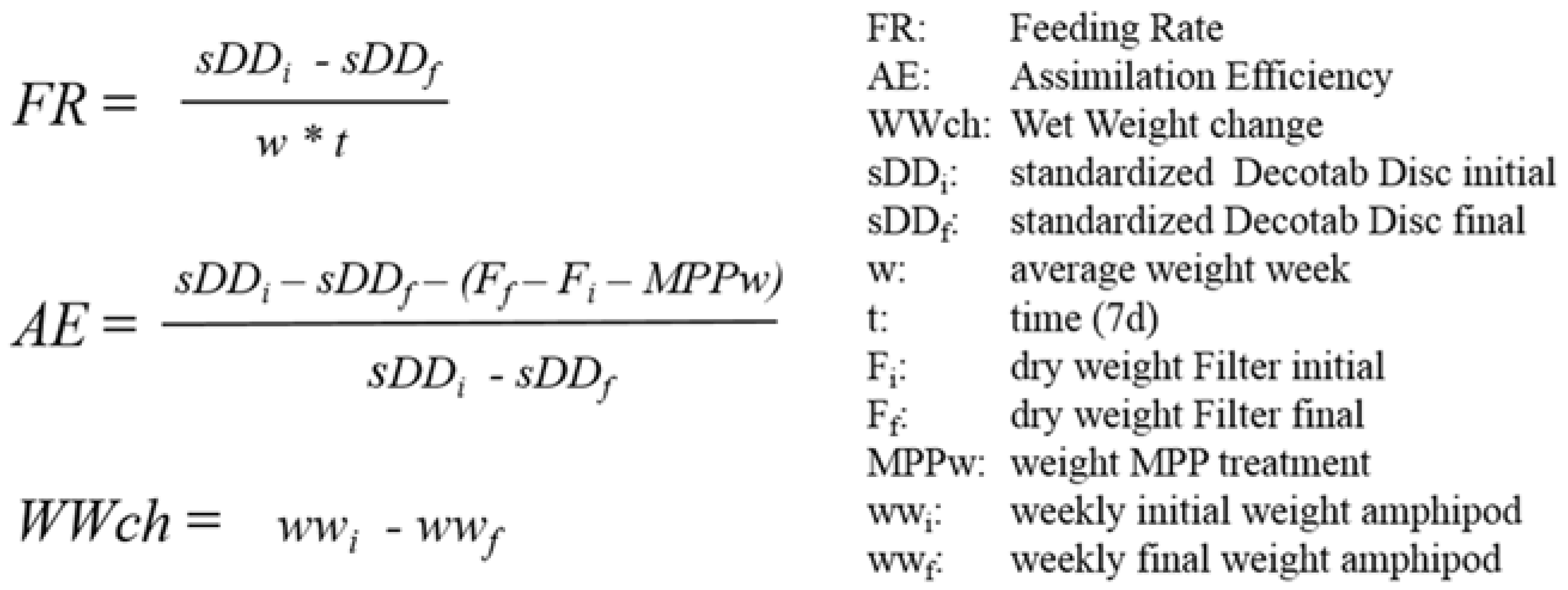

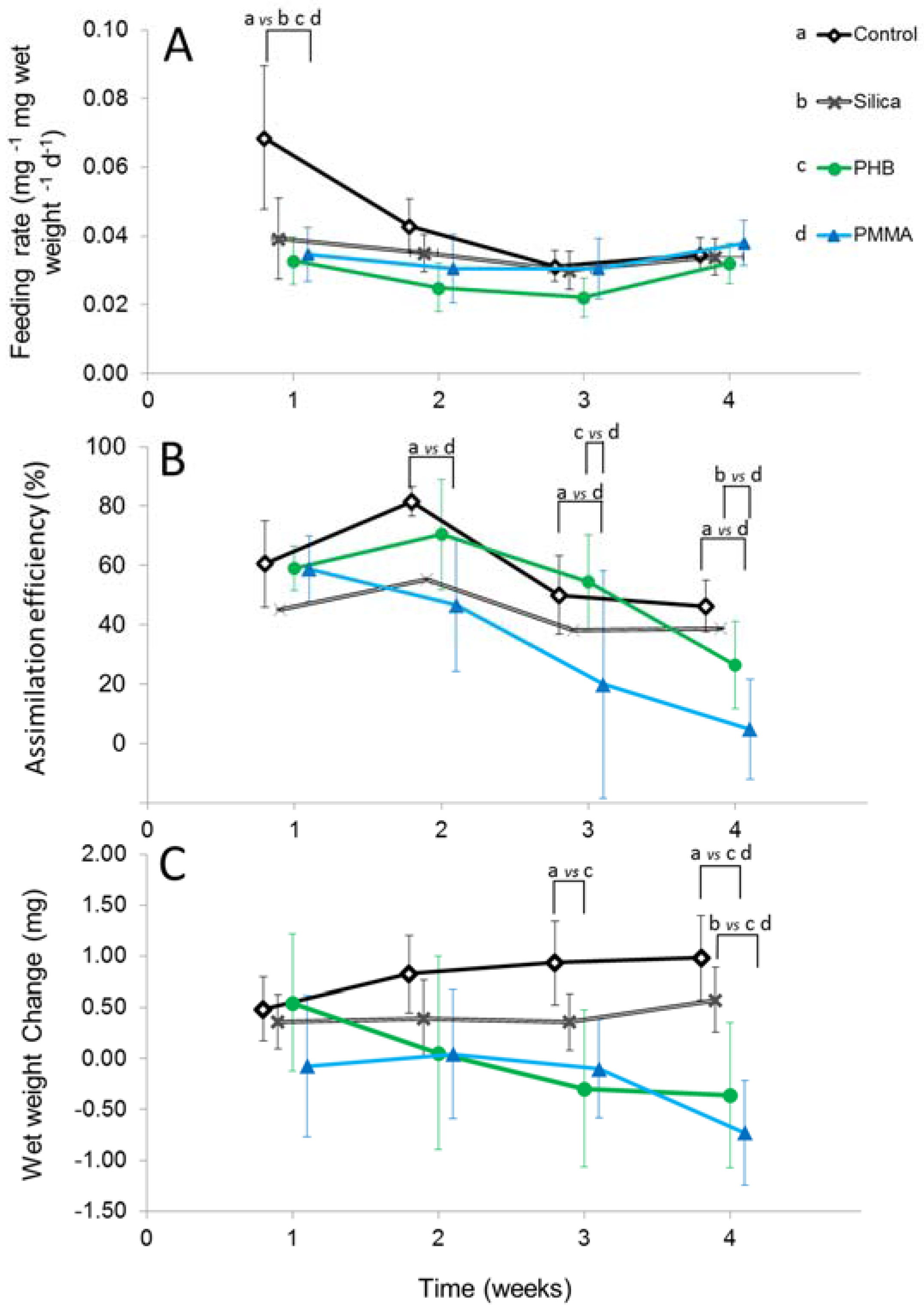
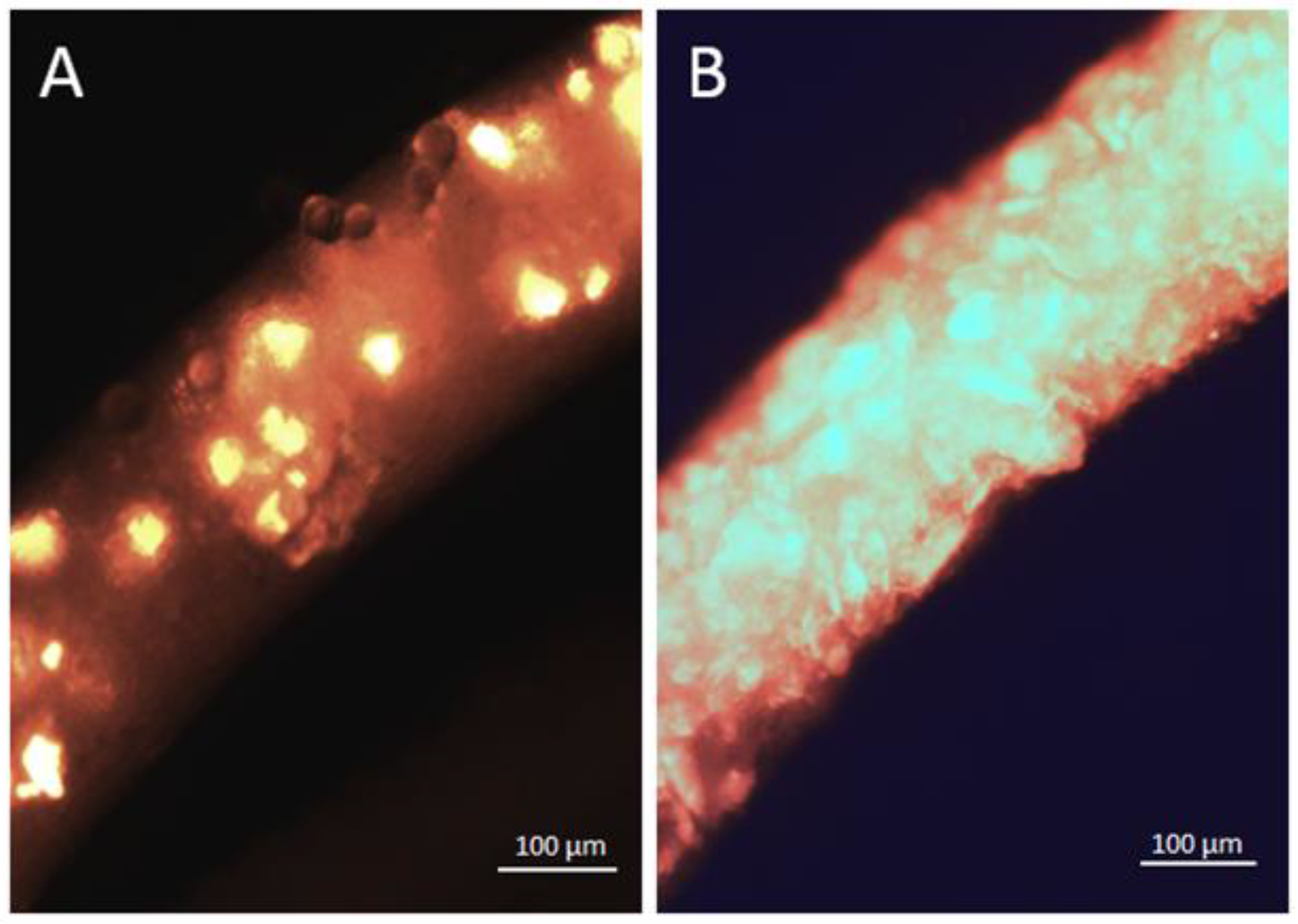
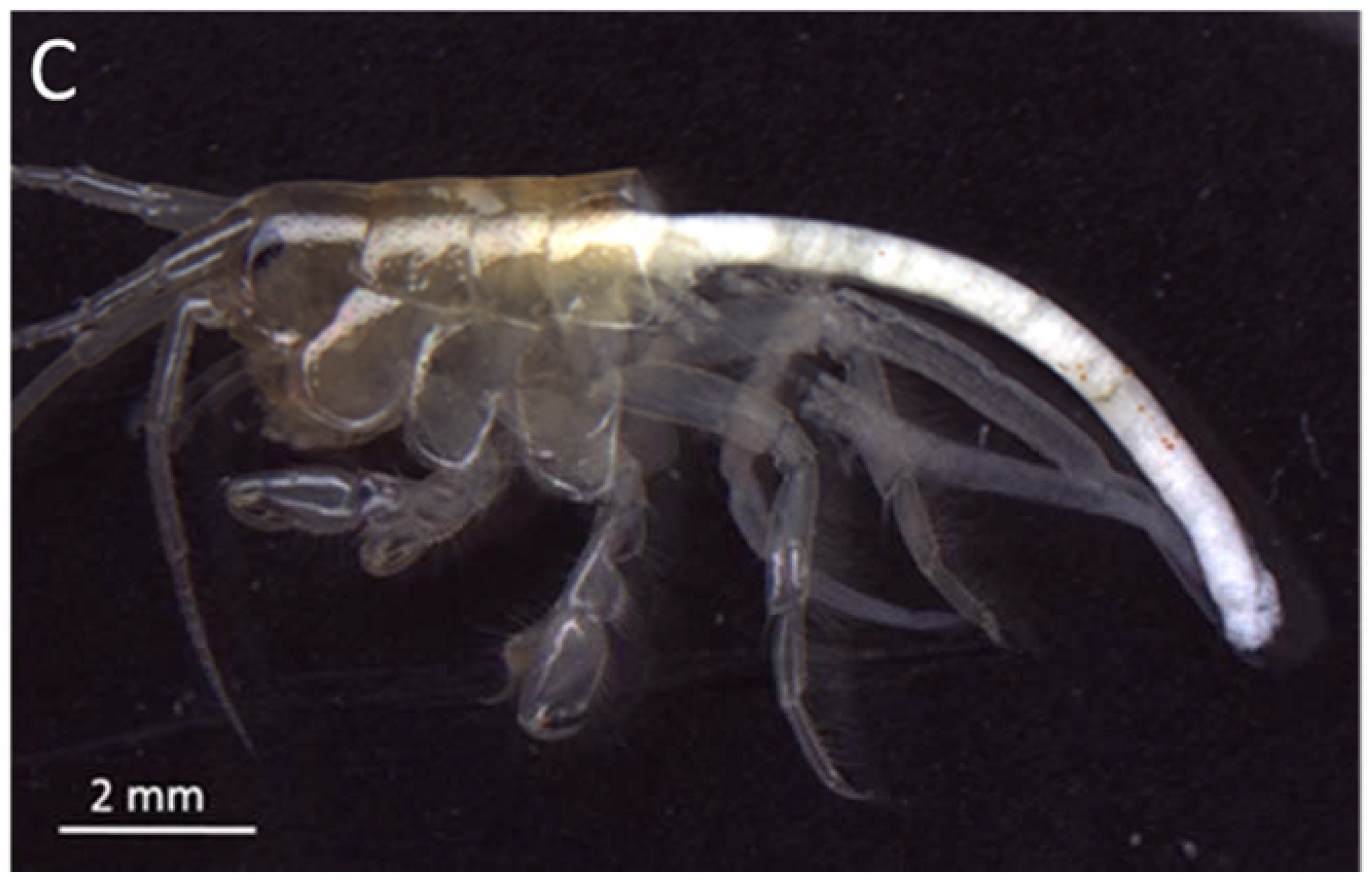
| MPP | PHB | PMMA |
|---|---|---|
| Density | 1.24 g cm−3 | 1.19 g cm−3 |
| Color | white, opaque | transparent |
| Form before grinding | pellets (3 mm) | pellets (3 mm) |
| MPP sizes after grinding | 32–64 µm | 32–64 µm |
| 64–125 µm | 64–125 µm | |
| 125–250 µm | 125–250 µm | |
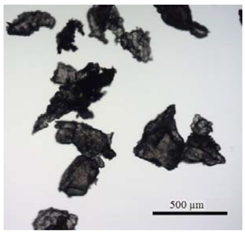 | 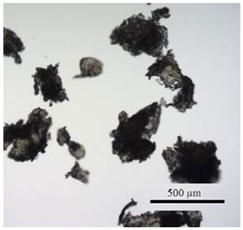 |
© 2017 by the authors. Licensee MDPI, Basel, Switzerland. This article is an open access article distributed under the terms and conditions of the Creative Commons Attribution (CC BY) license (http://creativecommons.org/licenses/by/4.0/).
Share and Cite
Straub, S.; Hirsch, P.E.; Burkhardt-Holm, P. Biodegradable and Petroleum-Based Microplastics Do Not Differ in Their Ingestion and Excretion but in Their Biological Effects in a Freshwater Invertebrate Gammarus fossarum. Int. J. Environ. Res. Public Health 2017, 14, 774. https://doi.org/10.3390/ijerph14070774
Straub S, Hirsch PE, Burkhardt-Holm P. Biodegradable and Petroleum-Based Microplastics Do Not Differ in Their Ingestion and Excretion but in Their Biological Effects in a Freshwater Invertebrate Gammarus fossarum. International Journal of Environmental Research and Public Health. 2017; 14(7):774. https://doi.org/10.3390/ijerph14070774
Chicago/Turabian StyleStraub, Sandrine, Philipp E. Hirsch, and Patricia Burkhardt-Holm. 2017. "Biodegradable and Petroleum-Based Microplastics Do Not Differ in Their Ingestion and Excretion but in Their Biological Effects in a Freshwater Invertebrate Gammarus fossarum" International Journal of Environmental Research and Public Health 14, no. 7: 774. https://doi.org/10.3390/ijerph14070774
APA StyleStraub, S., Hirsch, P. E., & Burkhardt-Holm, P. (2017). Biodegradable and Petroleum-Based Microplastics Do Not Differ in Their Ingestion and Excretion but in Their Biological Effects in a Freshwater Invertebrate Gammarus fossarum. International Journal of Environmental Research and Public Health, 14(7), 774. https://doi.org/10.3390/ijerph14070774





